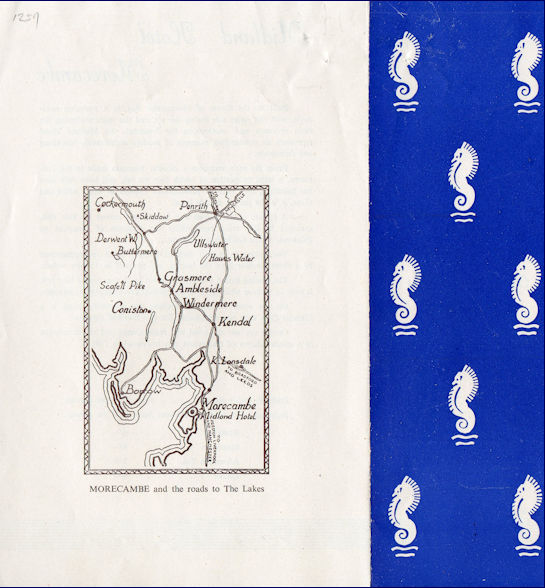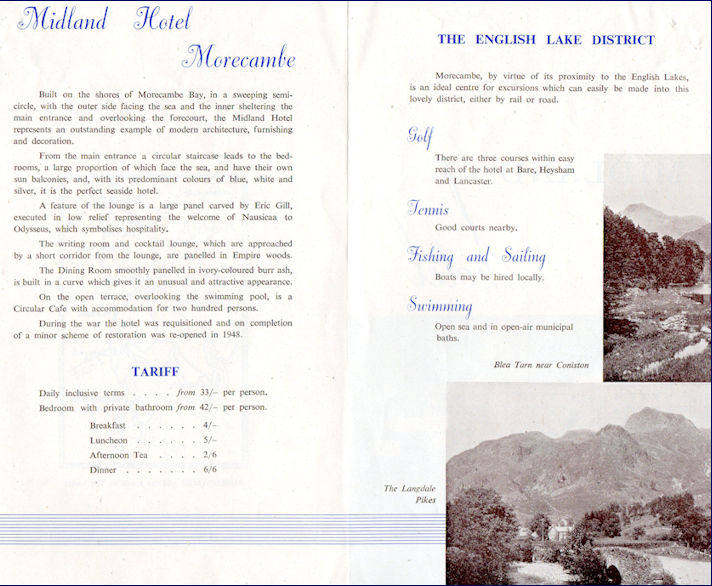The Midland Hotel - Morecambe
Home Page / Art Deco Home / Midland Home Page / Our Visits / Midland Gallery
Welcome to the The Midland Hotel - 1945 to 2000
1948
Brochure from July 1948 highlighting all the features of the hotel and surrounding area and including a map! No STD code for the telephone yet and the prices are in genteel shillings and pennies (no vulgar pounds!)
1949
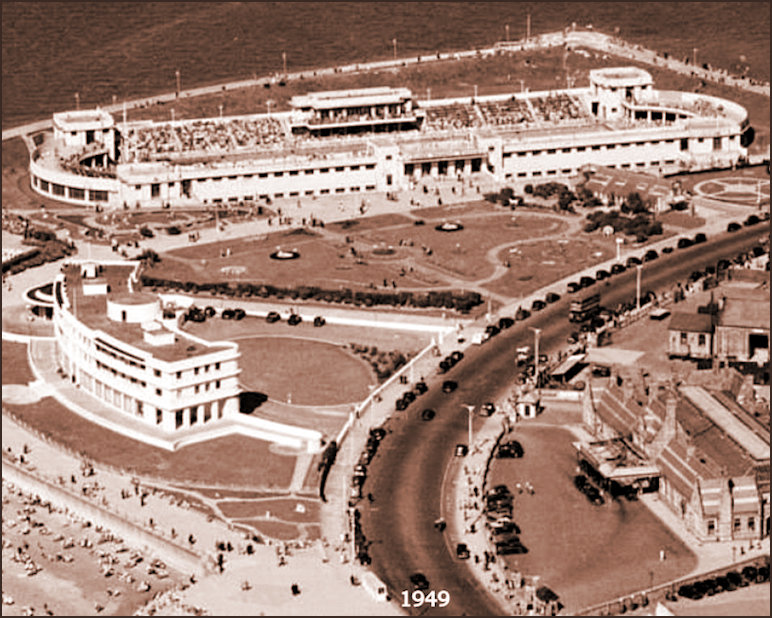
Wonderful aerial shot of the Midland Hotel and the Super Swimming Stadium
1951/2
l to r From the Lancaster Guardian dated Friday, 7th December 1951 and Friday, 25th July 1952 respectively, notice is given of the proposed Sale by the Hotels Executive of British Transport and eventual Purchase of the Midland Hotel to 'new management'.
1953 - Coronation Year
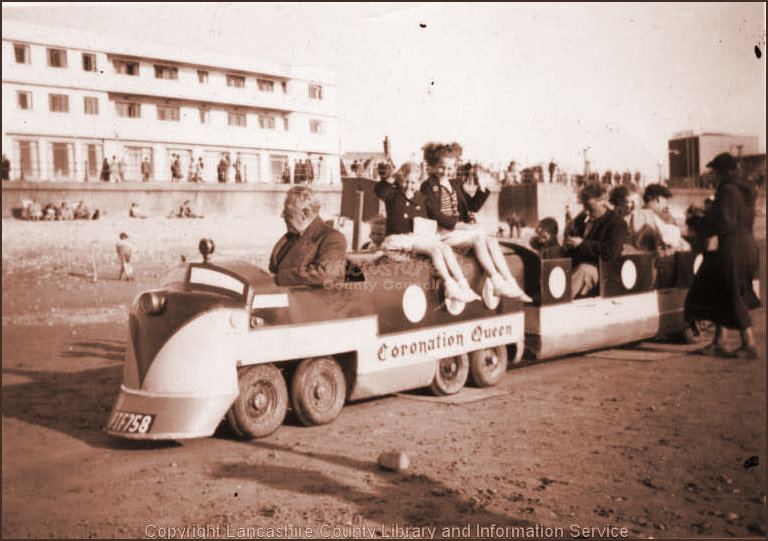
Celebrating HM the Queen's Coronation in 1953 - The 'Coronation Queen' - image © Lancashire County Library and Information Service
1950 - 1960s
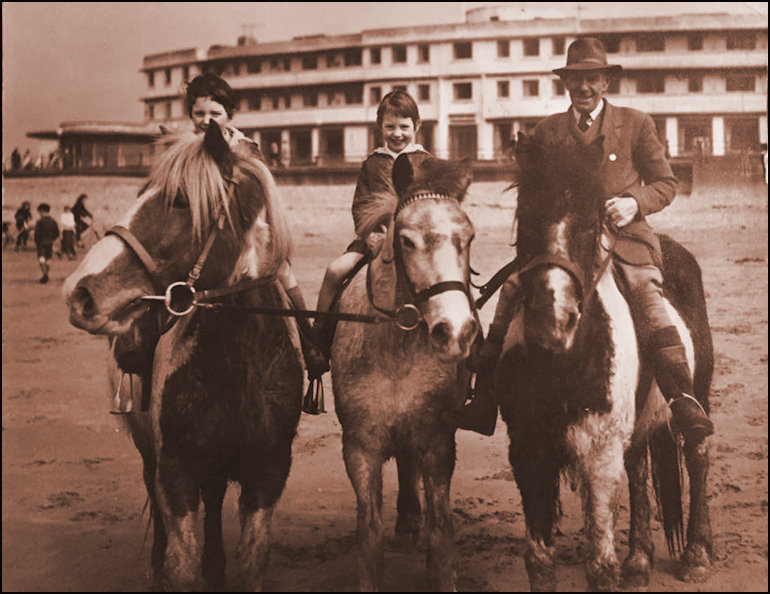
Jack Lupton, remembered fondly, with his ponies on the beach at the rear of a fairly tatty looking, but still functioning hotel - image courtesy of Jan Spence via the Morecambe and Heysham Past & Present Fb page (date of image guesstimated)
4-Star Rating
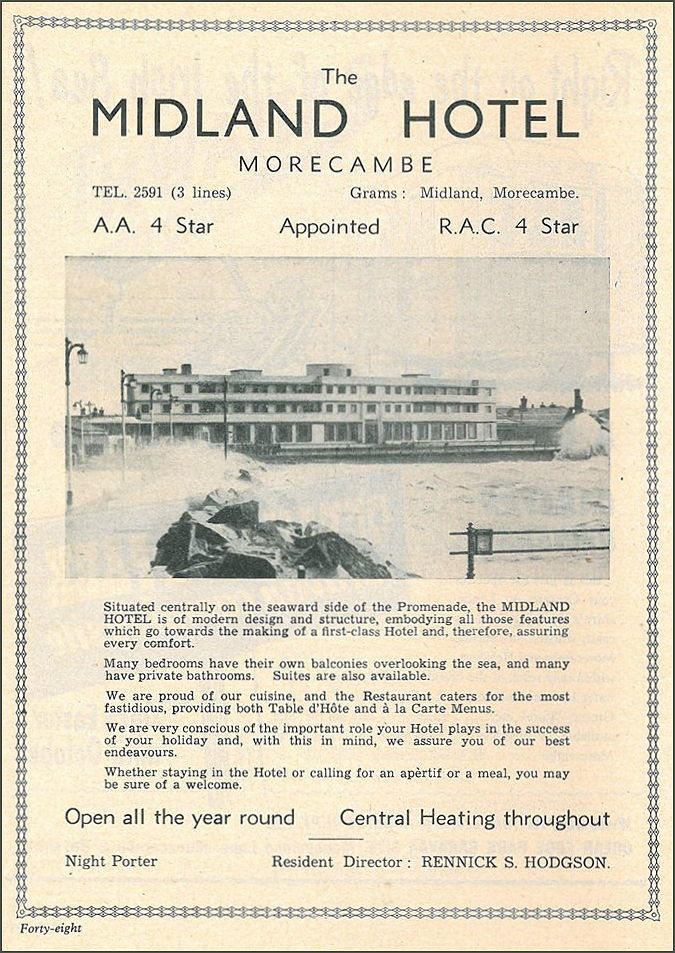
Looks like both the RAC and AA awarded a 4* rating to the hotel - date unknown but pre-STD codes! Image sourced from The Midland on Fb
1968 - Miss Great Britain
All the above images are screen dumps from BBC North West regional news programme transmitted on 6th June 2013
1970s
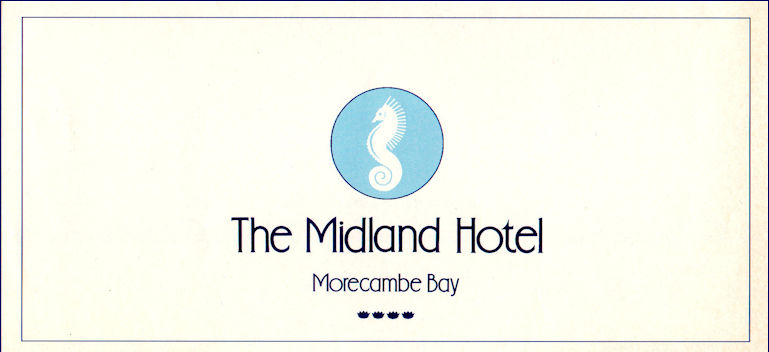
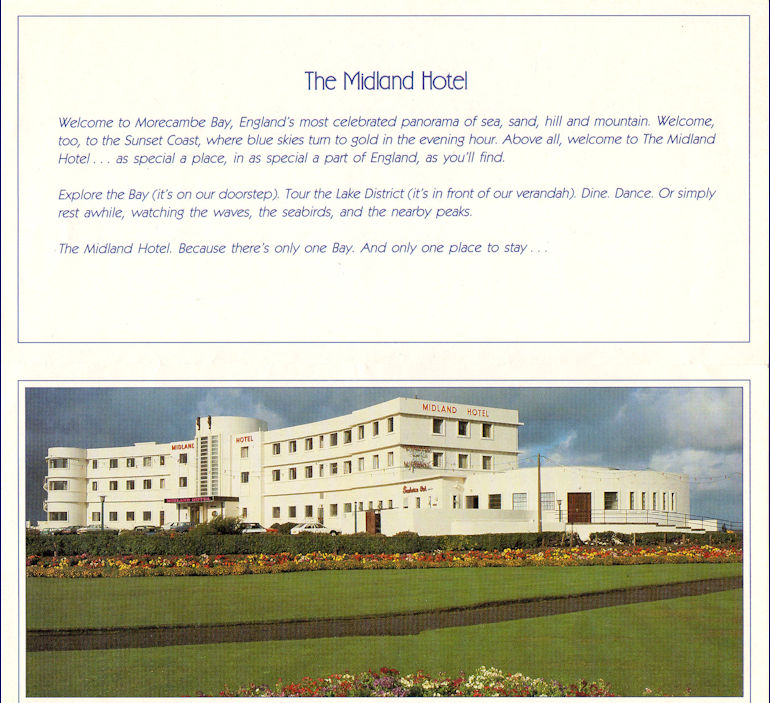
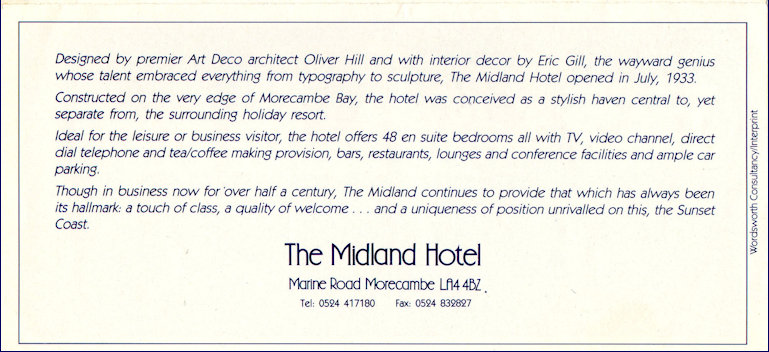
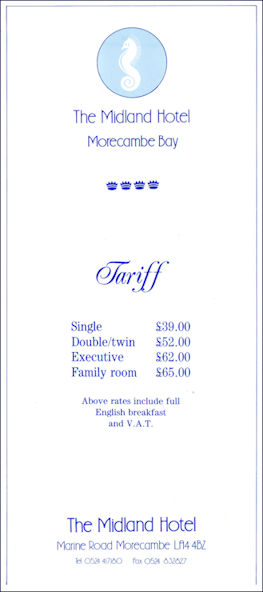
This brochure has a separate tariff to the original tri-fold - I surmise that this is because either prices went up or decimalisation came in (1971) - the brochure carries the new STD format for direct dialling (anywhere between 1958-1979) so I'm fairly confident this brochure belongs to the 1970s
1978
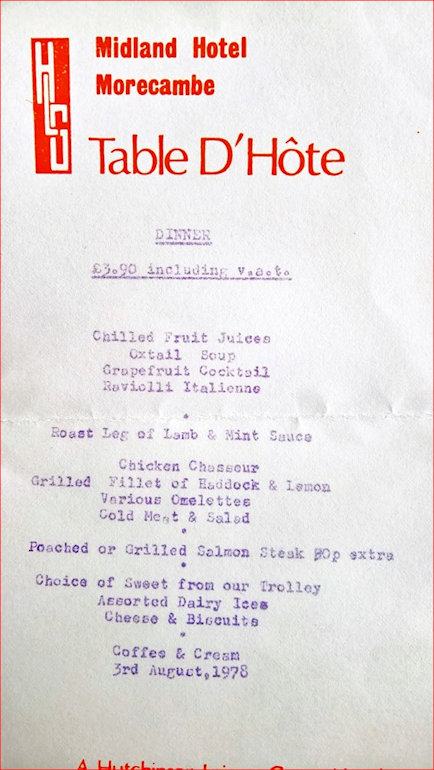
A menu dated 3rd August 1978 and offered by Phil Wilcock to the Morecambe & Heysham Fb page - the hotel was run by Hutchinson Leisure (Services?) at the time named after its then owner.
2000 - The Great Fish and Chip weekend
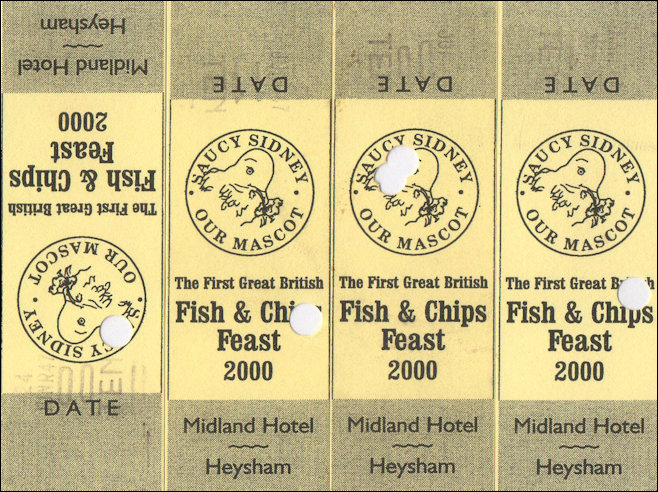
One of the visits not yet written up but coming soon!
Paradise lost for high jinks hotel - Daily Telegraph 14.05.1999
Built by a nudist, decorated by a paedophile, the Midland Hotel in Morecambe is a modern landmark that should be preserved, argues Kenneth Powell
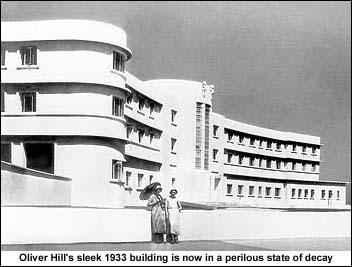 Twenty years after the Arts Council's ground-breaking Thirties exhibition, one of the key inter-war buildings in Britain, the Midland Hotel at Morecambe, is on the danger list - up for sale, its future distinctly uncertain.
Twenty years after the Arts Council's ground-breaking Thirties exhibition, one of the key inter-war buildings in Britain, the Midland Hotel at Morecambe, is on the danger list - up for sale, its future distinctly uncertain.
After decades of decline, the hotel is in need of a rescue operation. In 1930s Lancashire, the hotel must have seemed as futuristic as a set from Things to Come. Now, its sleek lines remain, but at close range the signs of decay are all too evident. Inside, the glamour has given way to typical seaside shabbiness - the place is struggling to survive, and it shows.
Yet the Midland is a major period monument. Like the career of its architect, Oliver Hill, it epitomises the aspirations - and contradictions - of the artistic and architectural world of the Thirties.
The auguries were never, in fact, good. The artist Eric Ravilious, brought in to paint murals of "Day" and "Night" for the tearoom and bar of the hotel in April 1933, a few months before the planned opening, battled against leaking flat roofs, burst radiators and, finally, cracking plaster, as well as indifferent contractors. Within two years, the Lancashire damp had triumphed. Ravilious's murals had almost completely vanished and the remains were whitewashed over. (The murals were recreated for an episode of the Poirot television series, a major generator of the current taste for Deco.)
The realities of the English climate were always at odds with the images - brilliant-white concrete set against blue seas - cherished by the architects and clients of the period. In Brighton and Bexhill, as in Morecambe, steel windows rotted in salt spray and chunks of concrete render spalled away. Today, the once-swish Midland seems something of a folly.
When new, it was part of an ambitious modernisation programme (including streamlined trains) adopted by the London, Midland & Scottish Railway. Despite (or perhaps because of) the Depression, British resorts were enjoying a revival. Morecambe had a strong following among the middle class of northern England and Scotland, and the LMS decided to replace the existing hotel (a gloomy Victorian pile) with a building of international quality in the modern style.
Hill, architect for the project, had been trained in the Arts and Crafts tradition. He built houses for the rich, using stone, timber and thatch with great skill, and pursued an Arts and Crafts lifestyle.
He was a lover of fresh air and a convinced nudist. On breaks from First World War trenches (where he served with distinction for four years and attained the rank of major), he encouraged his troops to sunbathe amid the shell craters.
The naked body was something of an obsession for him. During the 1920s, he published three volumes of photographs of naked children, accompanied by verses - a project which would today be regarded as very dubious, but which passed without comment at the time, as did the weekends he organised for groups of schoolgirls at his country retreat.
Hill was attracted by the architecture of the Continental Modern Movement. He regarded "modern", however, as a style rather than a way of life, to be picked up or dropped as necessary. Younger, more dogmatic modernists, for whom functionalism was the gospel, tended to regard him as a commercially inclined dilettant and purists deplored his habit of using brickwork, covered in render, instead of reinforced concrete.
By the early Thirties, however, Hill was designing highly convincing white-modern houses, which reflected the influence of Berthold Lubetkin, Le Corbusier and Alvar Aalto, and looking for larger commissions. The Midland was his biggest job to date and one which he appears to have particularly enjoyed.
The new Midland was a shrine to sunshine, fresh air and healthy recreation. It was also a showpiece for the applied arts. In addition to Ravilious, Marion Dorn was commissioned to design carpets and the leading sculptor and letter-cutter Eric Gill to carry out a number of works.
Although his own paedophiliac tendencies were, of course, unknown outside his family, Gill was a controversial and cranky figure. For the most important of the commissions, a large relief to be located in the hotel lounge, he proposed a depiction of "young things disporting themselves". Gill's drawing of naked girls and youths, described as High Jinks in Paradise, was shown to the LMS board - and immediately vetoed as far too racy.
Unabashed, Gill worked on alternative designs and that showing Odysseus welcomed from the Sea by Nausicaa was approved and duly executed. He also completed a mural on the staircase ceiling (originally intended to be covered with mosaic), a wall map for the children's lounge and a pair of stone seahorses for the exterior of the building.
With Gill's approval, Hill had High Jinks in Paradise worked up as an incised stone panel and eventually installed it in his own dining-room. There was a strongly sexual element to the Midland project - as the critic Alan Powers has pointed out, the hotel plan was that of a graphically depicted erect phallus.
Hill's career, like those of many of his contemporaries, was curtailed by the Second World War. His sincere interest in "social" architecture, particularly (and perhaps predictably) schools, resulted in only one completed scheme, at Castleford in Yorkshire - a stunning, light-filled building with an air of conviction lacking in the Midland. He built an equally striking concrete bus garage in east London, but there were no more major commissions.
He subsequently drifted into a tweedy eclecticism, characterised by relocation to the Cotswolds. There he designed craft exhibitions and street decorations for the Coronation of 1953 - and finally got married, at 66, to a girl a third his age. He renamed his young wife Titania and they lived a fairy-tale existence at Daneway, Sapperton, until Hill's death in 1968.
Hill's career perplexed the critics of the Sixties, who valued consistency and conviction above aesthetics. By the Seventies, his work was being rediscovered, as was that of Eric Gill, whose Odysseus relief from Morecambe was shown in the 1979 Thirties show at the Hayward.
The relief had been removed from the hotel (now listed) without consent and there were reports that the V & A wanted to acquire it. Eventually, the work was reinstated (though not in its original position) only to be uprooted again for the 1991 Gill exhibition at the Barbican Centre.
It took seven years of legal wrangling before the then owner of the Midland, Les Whittingham, was ordered to return the relief to Morecambe early last year. Nobody is certain what happened during the next six months, but by last autumn the crates containing the sections of the sculpture were reported missing, presumed stolen. Meanwhile, Mr Whittingham had died.
Local police seem to have given up the hunt for the missing Gill and, with the future of the Midland unclear (there have been ideas of converting the hotel into flats or a casino), the case for returning it there at present is debatable.
Yet the building is inseparable from the works of art created for it. The Midland features in the current Modern Britain exhibition at the Design Museum, and Alan Powers (one of the curators of the show) insists, "Until Oliver Hill is understood, the whole decade of the 1930s will remain mysterious."
Alongside the revolutionary dynamics of the Thirties, an older tradition of craftsmanship persisted. Oliver Hill was, almost uniquely, able to bridge the divide between modernism and tradition.
His work, hedonistic and even self-indulgent, may lack the purity and progressive zeal - and the breadth of imagination - of a Lubetkin or a Mendelssohn, yet Hill was a key populariser of modern architecture, selling it to clients who were not interested in social revolution.
The time is ripe for the Midland to be rescued.
Page refreshed: 25th March 2019 (G)

